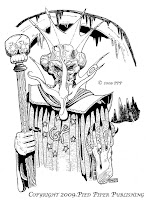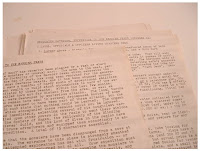There has been overwhelming interest in The Machine Level project. Besides my receiving many personal emails of encouragement on it, within a matter of 3 days the very topic stands at #2 for the month! Incredible! And thank you!
I do not attribute this interest alone to it being an original Greyhawk Castle level. The very fact that it prompts the imaginative viewing of a rich RPG landscape little explored is what I feel is the main attraction. In fact Black Blade Publishing had my 6 levels to choose from and elected to lead off with the Machine Level. Why? Why so much specific interest in this subject matter by fans, designers and the publisher?
That is the question I will attempt to answer here; and while doing so I will point back to D&D’s past and into its infinite future. I will expose a little known fact that its relation to other genres such as SF, Steam Punk, Sword & Planet, Planetary Romance, Post-Apocalyptic and other such related matter has never been far and away from the game as originally conceived and played-tested and that this easily included core matter was instead separated into distinct RPG types for commercial reasons only.
I begin the examination with a quote from the introductory article in which I stated: “Even though our genre inclusive game experience was soon to be fragmented into several RPG types—with medieval fantasy claiming sole rights in the original version of the game--this initial segmentation was a weighed choice made for D&D’s immediate commercial introduction only. We had previously felt that the game had more range and infinitely more possibilities than what the lone S&S element produced.”
What we had been play-testing in 1972 was the first role-playing game experience for us; and note that there is a different interpretation of "role-playing game experience" for those who purchased the game as consumers as opposed to those like myself who play-tested and contributed to it. Yes, it was a game in both cases. But moreover this was entirely new to us. It was role-playing. That’s what we keyed on during the play-tests, how to incorporate all imaginative RP elements, not just S&S RP elements. Yes, D&D in part derived from the Chainmail miniatures rules by way of Dave Arneson’s contribution of the F-RP element; and seemingly that would be consonant with it being a Medieval/Fantasy "experience" back then for us as it is now for you. But the idea of it being one type or another type was not as strong then as it was to become through its publication and being marketed as a game strictly derived from Swords & Sorcery.
Gary’s foreword to D&D attempts to clarify this apparent division and riddle by extolling the influence of the best selling author of the pulps and perhaps in the entire history of all such related literature, Edgar Rice Burroughs (I will expand on this idea fully in Part 2). David Arneson was so inclined as well, as he had been busy during D&D’s inception taking his players in Minneapolis into “The City of the Gods,” which was indeed the first, to my knowledge, RPG link between Fantasy and SF. More importantly regarding the latter, it was the first coupling of two distinct genres; and in my estimation there is a singularly important thread exposed in the above examples: these point to no other understanding or application of creative form than an open and inclusive one by both of D&D’s original authors and by both of their gaming groups.
Let me present some more examples extracted from my earliest days of playing the PC Robilar, as co-DM of the Greyhawk campaign alongside EGG, as EGG’s DM and finally as his co-author for GREYHAWK: Supplement 1, Mordenkainen’s Fantastic Adventure and other contributions by myself, Gygax and Arneson that I will note hereafter.
The elevator on level 3 (EGG/GrhCastle 1). Seems simple, but the idea is very complex for a supposed medieval society. And it wasn’t magical. Type: SF (i.e., future).
The Black Pudding/Slimes (EGG): This has been examined in depth. It is not the Horta from Star Trek; and as EGG did not have any C. A. Smith books on his shelf (I was to later introduce him to that master storyteller) there was no apparent influence there, so that really leaves such creatures to the beautiful camp movie, “The BLOB.” Type: SF/Horror.
Flesh Golem (EGG): Straight out of Mary B. Shelly’s, “Frankenstein.” Type: SF.
The ANGRY VILLAGER RULE (EGG; OD&D and its play-test): Taken right from the angry torch-wielding villagers present in the movie Frankenstein. Type: Modern day SF.
EGG as DM: Tenser’s trip to Mars, ala John Carter: Nothing more need be said. Type: SF/Planetary Romance.
Dinosaurs (EGG): Very much influenced by ERB’s “The Land that Time Forgot” and Verne’s “Journey to the Center of the Earth” and in all of their media forms. EGG found dinosaurs fascinating like all of us; it’s just that he never pulled out books on them as he did with Burrough’s fiction, nor did he not jump at a chance to watch such related matter on TV whether it was the two aforementioned titles, or similar. Type: Modern Hollow Earth theory/Lost Civ.
Shambling Mound (Arneson/EGG): From such comic book monsters as the “Swamp Thing,” the “Heap” and the “Man-Thing.” First encountered during our “Journey to the City of the Gods” adventure by myself and Gary and as DMed by Dave Arneson; later incorporated into the MM by EGG. Type: SF/Horror.
Mind Flayer (EGG): Influenced by Lumley’s “The Burrowers Beneath.” Type: Modern day Cosmic Horror.
Phantasmal Force Spell (EGG): Directly extracted from (and bragged about by EGG) ERB’s Thuvia, Maid of Mars where telepathic illusions of (Lotharian) archers fire illusionary arrows and kill those “believing” they are real. Type: SF/Planetary Romance.
Cerebral Parasite/Brain Mole/I.D. (EGG): These are alien creatures of the sort that appeared in different forms in SF, Horror or mixed. Greatest influence was the “Mind Parasites” by Colin Wilson. Type: SF/Space Horror.
Portable Hole (EGG): (1) the name is taken directly from the Looney Toons cartoon, “The Hole Idea.” (2) the bag of holding effect is from Jack Vance's story of "Chun the Unavoidable." [Thanks to Drew for absolutely jolting my memory on these two merged ideas]. Type: SF (modern fantastic invention)/Fantasy.
Bag of Tricks (Kuntz): Straight from the Felix the Cat cartoon, “The Magic Bag.” Type: Modern day Fantasy.
Tharizdun (and “Temple of,”)/Tharzdu’un (Gygax/Kuntz): The latter is based on 1.5 typed pages of my interpolation of Clark Ashton Smith’s Thasaidon and as reworked as an imprisoned Mythos god bent on destroying the planet. Used as a base by EGG to create the former. Type: Cosmic Horror.
Cube of Force (Kuntz): I always loved Star Trek force fields, but its prior influence derives from a great Outer Limits episode, “The Bellero Shield." Type: SF.
Magic Missile and Shield spells (EGG): From Roger Corman’s movie, “The Raven,” possibly one of EGG’s favorites as he always watched it when televised and enjoyed it immensely. Type: Victorian Occult Fantasy.
Giant Ants (EGG). Though one could easily place these as deriving from some fantastic literature of the past if they dug deep enough, the reality is they derive from two modern movies: “THEM”; and “THE NAKED JUNGLE." Type: Modern Day SF/Modern Disaster w/Horror elements.
Carrion Crawler (EGG): Very Mythos like. May be influenced by the pulps and HPL. May be original. Type: Undecided but studying.
Doppleganger (EGG): Similar to a changeling, put consistent with pulp or comic stories of those aliens who imitate forms. It has a strictly alien appearance in the MM. Type: SF/Space Horror.
Cult of Roloc/Mandarin (Kuntz; as per “Bottle City” and unpublished). I took the Mandarin name, his ring and the alien tech he learned/gained straight from Iron Man’s nemesis, Mandarin (see below for my inset drawing of the ring). Type: Modern/Futuristic SF fused with magical and spiritual (Far Eastern).
“Bottle City” mega-dungeon within a dungeon (Kuntz): The container and many inhabitants were influenced by the “Superman” Kandor storyline. Type: Several SF origins.
“Machine Level” (Kuntz): Comprehensive; mostly original, some influenced by strange inventors and their patented inventions. Type: SF/Future.
Ear Seeker (EGG): The “ear wig” out of the Rod Serling Night Gallery episode “The Caterpillar." Type: Modern/Horror.
Gelatinous Cube (EGG): Appears influenced by more Mythos HPL. Type: Horror/Undecided.
Narshuan’s Comet (Kuntz; “Sir Robilar’s City of Brass”): Directly inspired by those great Flash Gordon and Buck Rogers spaceships (see below for inset original mapped illustration). Type: SF/Planetary Romance
“City of the Gods” (Arneson): Inspired by A. E. Van Vogt’s, “Voyage of the Space Beagle." Type: SF.
 |
| Narshuan's "Comet" |
“Expedition to the Barrier Peaks” (EGG/from initial prepublication Origins tourney adventure by Kuntz): Type: SF/Space Horror.
“Dungeon of Krazor the Mad” (Kuntz): Where EGG (as Mordenkainen) discovered a rocket ship that launched and his PCs teleported out of. Type: Some solid SF elements.
“Fomalhaut” (Kuntz): Alien Mythos planar jump. Type: Cosmic Horror/Weird Fantasy.
Teleport Spell (EGG): Though occurring in many pulp and comic book stories under different guises, the idea was modernized by way of Star Trek’s transporter tech (using the same concept of “materializing in a solid object”). Type: SF/Various related genre takes.
“Church of the Later Day Ancient Ones” (Kuntz): Type: Mythos/Horror Elements/Arcane and Alien Science.
“The Dirdir (Level)” (EGG): Send up to Jack Vance’s Planet of Adventure series novel of the same name. Type: SF/Planet Adventure.
“Monkeying Around” (GrhCastle 2)/”Isle of the Ape” (EGG): Directly from “King Kong,” the 1933 movie. Type: Adventure/Lost Civ.
Lewis Carroll Pastiches (EGG; EX1, EX2): From “Alice's Adventures in Wonderland” and “Through the Looking-Glass.” Type: Transplanted Victorian era weird fantasy.
Cosmodius and his orbiting station (Kuntz): Type: Hard SF via a related Cosmic Horror story thread.
“Lost City of the Elders” (Kuntz): Main inspiration by Clark Ashton Smith’s “Empire of the Necromancers” and HPL’s “The Doom that Came to Sarnath,” with other significant elements. Type: Alien Science/SF/Post-Apocalyptic/Cosmic Horror.
The Great Stone Face Enigma of Greyhawk, GrhCastle 2 (EGG): Though EGG never admitted to its source, I always assumed it was at least partially influenced by the Easter Island Moai. Type: Mystery.
The Imprisoned Face in the Floor, GrhCastle 2 (EGG): Directly from A. Merritt’s, “The Face in the Abyss.” Type: Adventure/Supernatural/Lost Civ.
Fu’s Front (Kuntz; City of Greyhawk secret society/assassins): Inspired by Sax Rohmer’s Fu Manchu. Type: Modern.
“Garden of the Plantmaster” (Kuntz): Influenced by Clark Ashton Smith’s “The Garden of Adompha” and the “Maze of Maal Dweb.” Type: Cosmic Horror/Weird Fantasy/Heavy Supernatural.
“The Stalk” (Kuntz): The stalk component itself is straight from “Jack and the Beanstalk”; the shrinking component was heavily influenced by the movie, “The Incredible Shrinking Man.” Type: Elements of Folk-Fairy Tale/SF.
“Circle of “Eight”/The Gygaxian “Golden Horde” (EGG; and as DMed by Kuntz). EGG took this group’s insignia from the “Magic 8-Ball” fortune-telling device so popular back in the day; he patterned the Circle (and the moniker I attached to them) after the Mongols and Genghis Khan. Type: Elements of modern day culture/Historical.
Part 2 is in the works as recollections/writing merge…
All images and text Copyright their respective owners. All Rights Reserved.

















